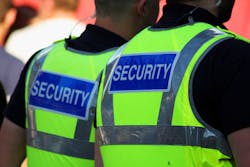Last August, Lt. Paul Kotter of the Utah Highway Patrol stopped a man outside a construction site close to a nearby Air Force base. Unbeknownst to Lt. Kotter, this man was armed. He fired at the lieutenant four times at close range. Fortunately for him, and many others, he was wearing his bullet proof vest, which saved his life. The covert vest he wore that day absorbed the bullets that otherwise would have killed him.
The majority of law enforcement officers are required to wear a bulletproof vest, and many opt for a covert vest so as not to give potential attackers any advantage; this may indeed have helped save Lt. Kotter’s life. However, there are many who, despite working in incredibly dangerous environments, are not required to wear body armor. For security personnel this protection is vital and yet some operate without it.
When thinking of bulletproof vests, most people will either picture tactical armor, complete with a ballistic helmet, or discreet protection hidden away until the dramatic reveal. While both tactical vests and covert vests are readily available to all, each will have their own advantages and disadvantages. For the vast majority of people, tactical armor is simply unnecessary and its weight and bulk will negate the high-caliber protection it can offer.
Most people will opt for a tactical vest because of this high-caliber protection, without realizing that the same levels of protection are available in covert vests. These vests, designed to be worn under clothing, can house protective plates that will stop even armor-piercing rounds, meaning you can be completely protected in a discreet and comfortable manner.
There are dangerous environments where discretion is still important, and tactical armor will simply not be appropriate. This is where covert armor shows its advantages, as it can be worn comfortably under clothing while still offering the same level of protection. This is of particular importance for close protection operatives, for example, who cannot sacrifice protection for discretion. Of course, it is unreasonable to expect those guarding high priority targets like CEOs to wear overt armor; this would bring far too much attention to them and defeat the purpose of them being there.
This is where covert armor becomes so useful, as it allows for all levels of protection without impeding on the CPO’s ability to do their job. The main benefit of covert armor over tactical armor is not only the discretion it provides but also in the flexibility that such a lightweight and thin vest brings. Covert armor allows for a wider range of movement than tactical armor, which is useful for situations where mobility is just as important as protection. Similarly, some covert armors incorporate temperature-regulating technologies that can keep the wearer cool by drawing moisture away from the skin.
Bullet-resistant vests are tested and graded according to their protection level in line with the standards set by the National Institute of Justice (NIJ). The NIJ is widely recognized as the world leader in ballistics testing, and it is important to ensure that any armor meets their standards. The majority of bulletproof vests can be found at Levels I through IIIa, which covers the ammunition most commonly used in handguns and semi-automatics. Most bulletproof vests are available at Level IIIa as a minimum, which will keep you protected against 9mm ammo at high velocities and even .44 Magnum rounds.
However, these are the strongest bullets Level IIIa armor is capable of protecting against. Body armor is capable of protecting against all manner of ammunition, including high-caliber rounds usually fired from rifles and automatics, and even armor-piercing ammunition. Protection at lower levels uses materials like Kevlar that are soft and flexible, yet still very strong. These work by "trapping" and flattening a bullet, dispersing its energy and slowing it until it comes to a complete stop.
Armor at higher levels still uses these materials, but needs additional protection to stop high-caliber rounds. Bulletproof vests at Level III or IV will therefore use rigid plates made from ceramics, polyethylene, or a blend of the two. These plates will absorb the bullet and deform around it, absorbing its energy in a similar way to Kevlar. These higher levels of protection can stop high-caliber ammunition like the as .308 Winchester or the 7.62mmx51mm NATO, but with an increase in weight and thickness. This increase is what usually leads people to choose tactical armor. However, advancements in material technologies mean the extra weight and bulk is negligible, and these rigid plates can be worn in covert vests quite comfortably.
Flexibility and mobility can be retained with a covert bulletproof vest, while also keeping the wearer cool. However, covert vests can also offer protection of the highest standard with extra protective plates. Traditionally, protection against high-caliber weaponry required full overt armor, in part because the expected threats necessitated complete protection, but also because the protection was not available in a covert style. New covert vest designs have pockets in the vest that sit over the Kevlar panels and can house rigid SAPI plates, thereby providing high-caliber protection. This means that you no longer have to distinguish between discretion and protection, as both are available in a comfortable and discreet package.



